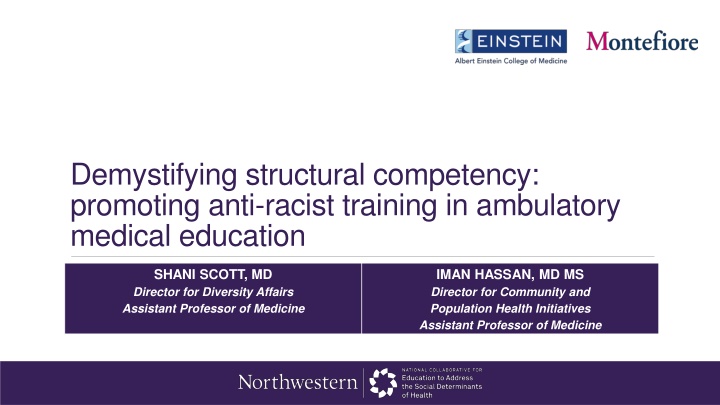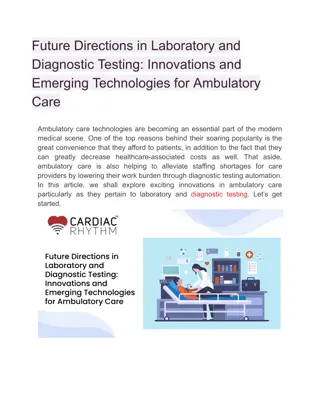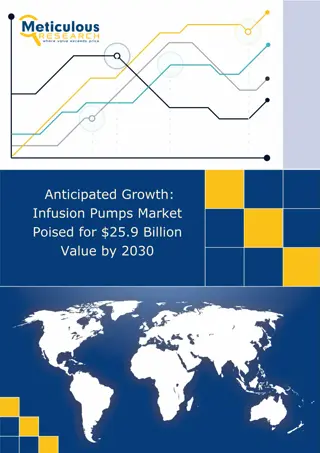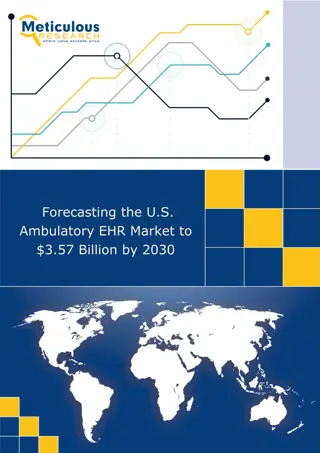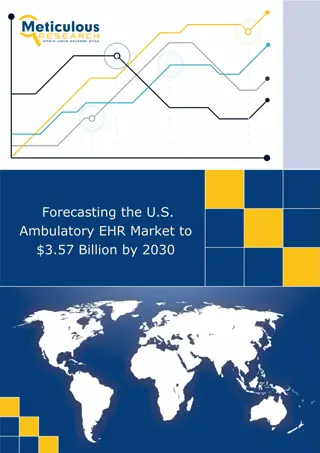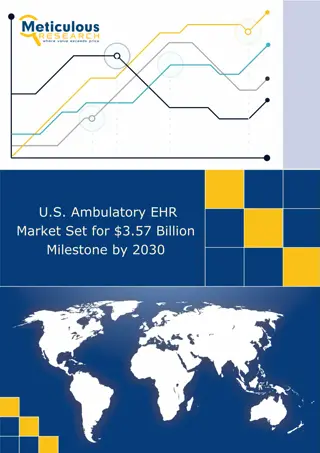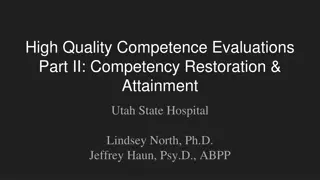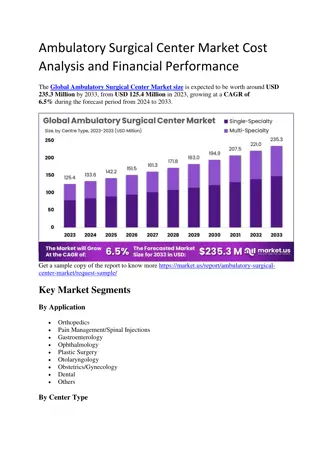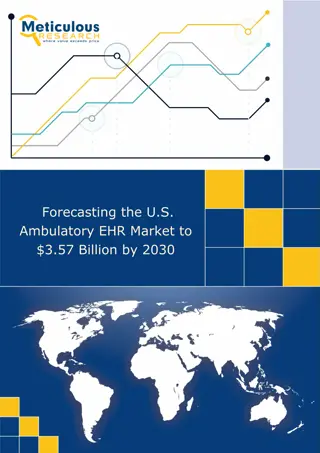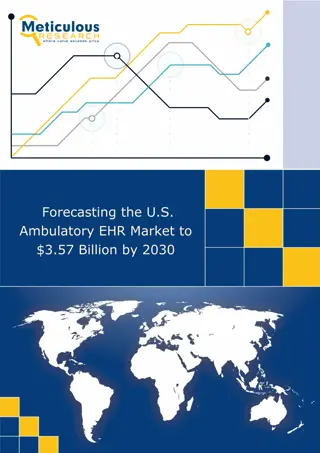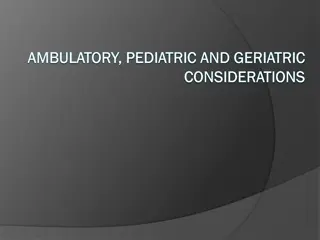Demystifying Structural Competency in Ambulatory Medical Education
Learn about structural competency and its importance in medical education. Discover how to incorporate social determinants of health into clinical encounters and develop a structural differential. Explore resources for contextualizing clinical problems within broader structural and historical narratives.
Download Presentation

Please find below an Image/Link to download the presentation.
The content on the website is provided AS IS for your information and personal use only. It may not be sold, licensed, or shared on other websites without obtaining consent from the author.If you encounter any issues during the download, it is possible that the publisher has removed the file from their server.
You are allowed to download the files provided on this website for personal or commercial use, subject to the condition that they are used lawfully. All files are the property of their respective owners.
The content on the website is provided AS IS for your information and personal use only. It may not be sold, licensed, or shared on other websites without obtaining consent from the author.
E N D
Presentation Transcript
Demystifying structural competency: promoting anti-racist training in ambulatory medical education SHANI SCOTT, MD Director for Diversity Affairs Assistant Professor of Medicine IMAN HASSAN, MD MS Director for Community and Population Health Initiatives Assistant Professor of Medicine
Learning Objectives By the end of this session, participants will be able to: Explain structural competency and its principles Construct a structural differential for case-based presentations Practice incorporating structural and social determinants of health into precepting encounters Identify resources for contextualizing clinical problems within broader structural and historical narratives
Structural Competency Defined The ability of health care providers and trainees to appreciate how symptoms, clinical problems, diseases and attitudes toward patients, populations and health systems are influenced by 'upstream' social determinants of health Developed by Vanderbilt s Center for Medicine, Health and Society director, Jonathan Metzl
In other words. Photo Credits: catholicschoolsny.org New York Daily News New York Transit Authority Beckers Hospital Review
Structural Determinants of Health Social Health Disparities Determinants of Health
Structural Competency Pillars 02 01 Identify structures that influence clinical encounters 03 Rearticulate cultural presentations in structural terms 05 Nurture awareness of structural humility 04 Observe and imagine structural interventions Develop an extra-clinical language of structure Developed by Vanderbilt s Center for Medicine, Health and Society director, Jonathan Metzl
Structural Competency is Important for Providers to learn.
Traditional Precepting Traditional Precepting
Mr. K who is 53 years old gentleman Hi Dr. Rae, tell me about the patient you saw today PMH: controlled DMT2, hypertension, CKD stage III, bilateral knee OA, obesity and asthma P/w follow-up visit.
First visit since the COVID-19 pandemic. Unchanged chronic pain in his left knee. Had COVID-19 two months ago. Unable to take his blood pressure medications for the last six weeks. Afebrile, BP is 172/85, with a BMI of 37. POC A1c is 8.1.
Ok, what do you think is going on with this patient? .
His first problem is his high blood pressure. Restart blood pressure combination pill. For his diabetes, start Metformin 1000mg BID and refer to health educator. Osteoarthritis, prescribe acetaminophen and diclofenac gel 1% for pain relief.
Good job on the health educator referral. Also, the patient s age and weight are likely also contributing to the progression of his OA.
What should you be concerned about when initiating metformin in this patient? The risk of lactic acidosis?
Start with Metformin 500mg Increasing kidney monitoring Counseling your patient about the risks of metformin with CKD.
Missed Missed opportunities? opportunities? What went What went well? well? Traditional Precepting Traditional Precepting Reflection Reflection
One Minute Preceptor (OMP) The one minute preceptor is a teaching model that allows the preceptor to take full advantage of the entire encounter in order to maximize the time available for teaching. Neher J, Gordon K, Meyer B, Stevens N. A five-step microskills model of clinical teaching. Journal of American Board of Family Practice, 1992; 5: 419-424.
Structurally Competent OMP Encourage learners to develop their critical thinking and clinical reasoning skills. Microskill 1: Get a commitment to a structural problem related to the case Actively engage the learners to commit to a structural differential for a chief complaint.
Example Preceptor Prompts What structural contributors are effecting this patient s chief complaint? Is this patient potentially effected by a health disparity? If so, how does that change your problem list? What is your number one differential and why would this patient be disproportionately affected by this diagnosis?
Structurally Competent OMP Uncover biases in the student decision Guess vs. reasonable foundation of knowledge? Microskill 2: Probe for supporting evidence & address implicit bias Discuss structural humility Check for potential harmful effects from implicit bias
Example Preceptor Prompts I see you chose the lower cost medication. How did you come to this decision? How do you feel about your time management/workflow in clinic today? We are more likely to introduce bias into our thinking when we feel rushed. What are the patient s perceptions on their current medical condition?
Structurally Competent OMP Provide positive feedback that reinforces desired behaviors, knowledge, skills, or Miscroskill 3: Reinforce what was done well attitudes.
Example Preceptor Prompts Great work on identifying the patient s current quality of housing and exposures to environmental pollutants when developing your differential for cough! That was a comprehensive social history, and I am glad you used the social determinants of health screening tool! Nice job on identifying transporting challenges for our patients post-op visit and reaching out to their PCP!
Approach the learner respectfully Structurally Competent OMP Microskill 4: Give guidance about errors/omissions Timely feedback. Address gaps in the social history, failure to incorporate the social determinants of health, or failure to develop a structural differential.
Example Preceptor Prompts I see you mentioned medication non-adherence as a reason for your patient s uncontrolled asthma. Did you probe further? Why is is it important to assess for structural factors contributing to your patients uncontrolled asthma? During your presentation, the social history was limited and only reported toxic habits . How can you expand/ strengthen this part of the presentation?
Structurally Competent OMP Recognize upstream structures that shape clinical encounters Develop an extra-clinical language of structure Rearticulate cultural presentations in structural terms Observe/imagine structural interventions Demonstrate and cultivate structural humility Microskill 5: Teach core structural competencies
Structurally Competent OMP Concluding the learning encounter with reflections and next steps. Researching interventions at the Summarize individual, clinic, community, or policy level Reading assignment on health disparities and structural contributors.
Structural Differential Develop solutions to address structural problems Generate a prioritized structural problem list Identify structural root causes for clinical problems Create a prioritized clinical problem list Bui T, Hassan I. AMA; 2019. & Seymour C, Griffin C, Holmes SM, Martinez C. NEJM; 2018.
Clinical Problem List: Uncontrolled asthma with frequent asthma attacks Create a prioritized clinical problem list
Using a structural vulnerability assessment, you discover: Mold, Pests, Leaks Identify structural root causes for clinical problems Uncontrolled Asthma Gentrification Landlord Neglect
Structural Problem List: Uncontrolled asthma with frequent asthma attacks Poor housing conditions stemming from landlord neglect, exacerbated by gentrification Generate a prioritized structural problem list
Poor housing conditions interventions: Individual Level: Offer resources to report housing violations Link to community health worker home based- asthma program Develop solutions to address structural problems Health System Level: Refer to clinic s medical legal partnership Community/Societal Level: Support tenet-led efforts to form a tenet s association with help from housing rights advocates Join larger community-led policy efforts to mitigate gentrification
Structurally Competent Structurally Competent Precepting Precepting
Mr. K who is 53 years old gentleman Hi Dr. Rae, tell me about the patient you saw today PMH: controlled DMT2, hypertension, CKD stage III, bilateral knee OA, obesity and asthma P/w follow-up visit.
First visit since the COVID-19 pandemic. Unchanged chronic pain in his left knee. Had COVID-19 two months ago. Unable to take his blood pressure medications for the last six weeks. Afebrile, BP is 172/85, with a BMI of 37. POC A1c is 8.1.
# 1 Get a commitment to a structural problem Mr. K contracted COIVD-19 and his mother passed. How did COVID-19 impact him? What happened that prevented him from taking his medications? He is out of work. He did not pick up his medications from the pharmacy.
# 2 Probe for supporting evidence & address implicit bias. Ask the patient his thoughts on medication and HTN In the meantime, what is your assessment and plan?
His first problem is his high blood pressure. Restart blood pressure combination pill. For his diabetes, start Metformin 1000mg BID and refer to health educator. Osteoarthritis, prescribe acetaminophen and diclofenac gel 1% for pain relief.
# 3 Give Positive Feedback Good job on the health educator referral. Also, the patient s age and weight are likely also contributing to the progression of his OA.
What should you be concerned about when initiating metformin in this patient? The risk of lactic acidosis?
# 4 Give Guidance about errors/omissions CKD-EPI equation to calculate GFR and cautiously interpret corrections for race Start with Metformin 500mg Increasing kidney monitoring Counseling about the risks of metformin with CKD
Practicing One Minute Preceptor & Structural Differential Breakout Session
How was the precepting experience? Large Group Discussion How did you use the steps of the structural differential in your group? What limitations did you experience in this encounter, how might you address differently next time?
Resources Diversity @ Einstein - Anti-Racism Resources - LibGuides at Albert Einstein College of Medicine (einsteinmed.org) Structural Competency Working Group | Berkeley, CA | structcomp.org Research on Integrating Social & Medical Care | SIREN | Evidence Library (ucsf.edu) STFM Antiracism & Health Equity Resources (stfm.org)
Acknowledgements Thuy Bui MD, University of Pittsburgh College of Medicine Diana Avendano Morineau, Montefiore Learning Network Richard Schwab, Montefiore Learning Network Cristina Gonzalez MD MEd, Albert Einstein College of Medicine
